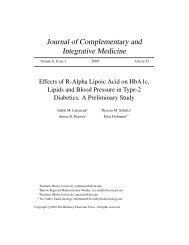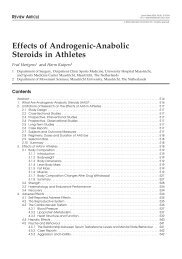Chemistry and Biochemistry of HCA.pdf - AFBoard.com
Chemistry and Biochemistry of HCA.pdf - AFBoard.com
Chemistry and Biochemistry of HCA.pdf - AFBoard.com
Create successful ePaper yourself
Turn your PDF publications into a flip-book with our unique Google optimized e-Paper software.
12 J. Agric. Food Chem., Vol. 50, No. 1, 2002 Reviews<br />
Table 1. Comparison <strong>of</strong> Physical Properties <strong>of</strong> <strong>HCA</strong> <strong>and</strong> Lactones<br />
from Garcinia <strong>and</strong> Hibiscus (23)<br />
property<br />
free<br />
acid<br />
Garcinia<br />
lactone<br />
free<br />
acid<br />
Hibiscus<br />
lactone<br />
mp (°C) 178 183<br />
[R] 20 D (deg) −20 100 122 31<br />
crystal shape needles needles<br />
hygroscopicity slight high<br />
solubility<br />
high in alcohol<br />
<strong>and</strong> water; fair<br />
in ether<br />
paper chromatogr (R f)<br />
butanol/formic acid/H 2O 0.24 0.42 0.15 0.39<br />
propanol/acetic acid/H 2O 0.26 0.36 0.35 0.26<br />
metav<strong>and</strong>ate spray (5%) yellow reddish orange yellow yellow<br />
high in water<br />
<strong>and</strong> alcohol;<br />
slight in ether<br />
Stereochemistry. Hydroxycitric acid (1,2-dihydroxypropane-<br />
1,2,3-tricarboxylic acid) has two asymmetric centers; hence, two<br />
pairs <strong>of</strong> diastereoisomers or four different isomers are possible<br />
(Figure 1). Martius <strong>and</strong> Maue (33) have synthesized the four<br />
possible stereoisomers <strong>of</strong> hydroxycitrate. One <strong>of</strong> these isomers<br />
occurs in Garcinia (Figure 1, I) <strong>and</strong> another in Hibiscus species<br />
(Figure 1, II) (24). The absolute configurations <strong>of</strong> the hydroxycitric<br />
acid lactones, hibiscus acid <strong>and</strong> garcinia acid, were<br />
determined to be (2S,3R)- <strong>and</strong> (2S,3S)-2-hydroxycitric acid-2,5-<br />
lactone, respectively (Figure 2). The absolute configuration is<br />
determined from Hudson’s lactone rule, optical rotatory dispersion<br />
curves, circular dichrosim curves, <strong>and</strong> calculation <strong>of</strong> partial<br />
molar rotations (34). Glusker et al. (35, 36) have reported the<br />
structure <strong>and</strong> absolute configuration <strong>of</strong> the calcium hydroxycitrate<br />
<strong>and</strong> (-)-<strong>HCA</strong> lactone by X-ray crystallography. Stallings<br />
et al. (37) have reported the crystal structures <strong>of</strong> the ethylenediamine<br />
salts <strong>of</strong> diastereoisomeric hydroxycitrates.<br />
Properties <strong>of</strong> ())-<strong>HCA</strong> <strong>and</strong> Lactone. The physical properties<br />
<strong>of</strong> (-)-<strong>HCA</strong> <strong>and</strong> lactones (Figure 2) from Garcinia <strong>and</strong><br />
Hibiscus are presented in Table 1. The equivalent weight <strong>of</strong><br />
pure lactone is 69, as determined by alkali titration or silver<br />
salt de<strong>com</strong>position. The IR spectra <strong>of</strong> the ethyl ester showed<br />
ester <strong>and</strong> hydroxyl groups at 5.41-5.76 <strong>and</strong> 2.74-2.79 µ,<br />
respectively (23). The structure <strong>of</strong> the (-)-<strong>HCA</strong> lactone was<br />
further established by IR <strong>and</strong> 1 H NMR spectroscopy. The (-)-<br />
<strong>HCA</strong> lactone displayed strong IR b<strong>and</strong>s at 3200, 1760, <strong>and</strong> 1680<br />
cm -1 . 1 H NMR spectra <strong>of</strong> the (-)-<strong>HCA</strong> lactone showed two<br />
protons at the γ-carbon, which give an AB quartet at δ 2.53<br />
<strong>and</strong> δ 2.74 with J ) 17.1 Hz, <strong>and</strong> one proton at the R-carbon<br />
showing a singlet at δ 5.15 (38).<br />
Estimation <strong>of</strong> ())-<strong>HCA</strong>. Free (-)-<strong>HCA</strong> leads to the<br />
formation <strong>of</strong> (-)-<strong>HCA</strong> lactone during concentration <strong>and</strong> evaporation.<br />
The presence <strong>of</strong> minor organic acids such as citric acid,<br />
tartaric acid, <strong>and</strong> malic acid in the Garcinia fruits <strong>and</strong> the lack<br />
<strong>of</strong> <strong>of</strong>ficial methods for the assay <strong>of</strong> (-)-<strong>HCA</strong> have created<br />
confusion <strong>and</strong> disagreement among analysts (39). The existing<br />
method for the determination <strong>of</strong> (-)-<strong>HCA</strong> content in G.<br />
cambogia extract involves acid-base titration, which gives the<br />
total acidity <strong>of</strong> the extract (40). However, in this method the<br />
concentrations <strong>of</strong> (-)-<strong>HCA</strong> <strong>and</strong> lactone cannot be estimated<br />
separately.<br />
Lowenstein <strong>and</strong> Brunengraber (25) have estimated the hydroxycitrate<br />
content <strong>of</strong> the fruit <strong>of</strong> G. cambogia by gas<br />
chromatography (GC). GC estimation involves the conversion<br />
<strong>of</strong> acid to volatile silyl derivative. They used an OV-17 GC<br />
column (3 m × 3 mm i.d.). The column was run at 145 °C<br />
using nitrogen as the carrier gas (40 mL/min) with an injection<br />
port temperature <strong>of</strong> 250 °C <strong>and</strong> a detector temperature <strong>of</strong> 300<br />
°C. (-)-<strong>HCA</strong> lactone is the major constituent <strong>of</strong> the extract,<br />
Figure 3. Structures <strong>of</strong> hydroxycitric acid derivatives.<br />
<strong>and</strong> the recrystallized <strong>com</strong>pound contains




